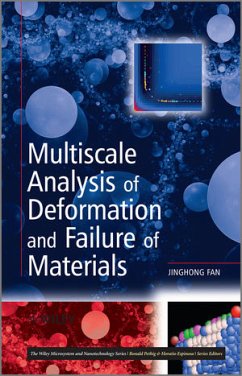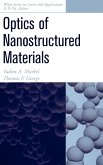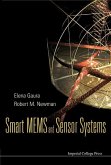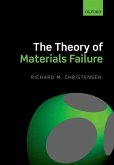Jinghong Fan
Multiscale Analysis of Deformation and Failure of Materials
Jinghong Fan
Multiscale Analysis of Deformation and Failure of Materials
- Gebundenes Buch
- Merkliste
- Auf die Merkliste
- Bewerten Bewerten
- Teilen
- Produkt teilen
- Produkterinnerung
- Produkterinnerung
Multiscale Analysis of Deformation and Failure of Materials systematically describes the background, principles, and methods within the exciting new field of multiscale analysis. It provides a digestible introduction to the complexities of the interdisciplinary field of multiscale modeling of deformation and failure analysis of materials, respecting the reader's need to critically think and absorb both information and perspective. This type of multiscale analysis has a broad scope of applications, encompassing different disciplines and practices and is an essential extension of…mehr
Andere Kunden interessierten sich auch für
![Nanolubricants Nanolubricants]() Jean M. MartinNanolubricants162,99 €
Jean M. MartinNanolubricants162,99 €![Optics of Nanostructured Materials Optics of Nanostructured Materials]() Vadim A. MarkelOptics of Nanostructured Materials282,99 €
Vadim A. MarkelOptics of Nanostructured Materials282,99 €![Smart MEMS and Sensor Systems Smart MEMS and Sensor Systems]() Elena GauraSmart MEMS and Sensor Systems248,99 €
Elena GauraSmart MEMS and Sensor Systems248,99 €![Theory of Materials Failure Theory of Materials Failure]() Richard M ChristensenTheory of Materials Failure154,99 €
Richard M ChristensenTheory of Materials Failure154,99 €![Convergence of More Moore, More Than Moore and Beyond Moore Convergence of More Moore, More Than Moore and Beyond Moore]() Convergence of More Moore, More Than Moore and Beyond Moore197,99 €
Convergence of More Moore, More Than Moore and Beyond Moore197,99 €![Advances in Nanoengineering: Electronics, Materials and Assembly Advances in Nanoengineering: Electronics, Materials and Assembly]() J Michael T ThompsonAdvances in Nanoengineering: Electronics, Materials and Assembly189,99 €
J Michael T ThompsonAdvances in Nanoengineering: Electronics, Materials and Assembly189,99 €![Advanced Indium Arsenide-Based HEMT Architectures for Terahertz Applications Advanced Indium Arsenide-Based HEMT Architectures for Terahertz Applications]() Advanced Indium Arsenide-Based HEMT Architectures for Terahertz Applications153,99 €
Advanced Indium Arsenide-Based HEMT Architectures for Terahertz Applications153,99 €-
-
-
Multiscale Analysis of Deformation and Failure of Materials systematically describes the background, principles, and methods within the exciting new field of multiscale analysis. It provides a digestible introduction to the complexities of the interdisciplinary field of multiscale modeling of deformation and failure analysis of materials, respecting the reader's need to critically think and absorb both information and perspective. This type of multiscale analysis has a broad scope of applications, encompassing different disciplines and practices and is an essential extension of mesomechanics.
Presenting cutting-edge research and development within multiscale modeling techniques and frameworks, Multiscale Analysis of Deformation and Failure of Materials systematically describes the background, principles and methods within this exciting new & interdisciplinary field. The author's approach emphasizes the principles and methods of atomistic simulation and its transition to the nano and sub-micron scale of a continuum, which is technically important for nanotechnology and biotechnology. He also pays close attention to multiscale analysis across the micro/meso/macroscopy of a continuum, which has a broad scope of applications encompassing different disciplines and practices, and is an essential extension of mesomechanics. Of equal interest to engineers, scientists, academics and students, Multiscale Analysis of Deformation and Failure of Materials is a multidisciplinary text relevant to those working in the areas of materials science, solid and computational mechanics, bioengineering and biomaterials, and aerospace, automotive, civil, and environmental engineering. * Provides a deep understanding of multiscale analysis and its implementation * Shows in detail how multiscale models can be developed from practical problems and how to use the multiscale methods and software to carry out simulations * Discusses two interlinked categories of multiscale analysis; analysis spanning from the atomistic to the micro-continuum scales, and analysis across the micro/meso/macro scale of continuum * Accompanying the last chapter is the development of a Computational Simulation Laboratory Infrastructure (CSLI) that can be dowloaded from the book website
Hinweis: Dieser Artikel kann nur an eine deutsche Lieferadresse ausgeliefert werden.
Presenting cutting-edge research and development within multiscale modeling techniques and frameworks, Multiscale Analysis of Deformation and Failure of Materials systematically describes the background, principles and methods within this exciting new & interdisciplinary field. The author's approach emphasizes the principles and methods of atomistic simulation and its transition to the nano and sub-micron scale of a continuum, which is technically important for nanotechnology and biotechnology. He also pays close attention to multiscale analysis across the micro/meso/macroscopy of a continuum, which has a broad scope of applications encompassing different disciplines and practices, and is an essential extension of mesomechanics. Of equal interest to engineers, scientists, academics and students, Multiscale Analysis of Deformation and Failure of Materials is a multidisciplinary text relevant to those working in the areas of materials science, solid and computational mechanics, bioengineering and biomaterials, and aerospace, automotive, civil, and environmental engineering. * Provides a deep understanding of multiscale analysis and its implementation * Shows in detail how multiscale models can be developed from practical problems and how to use the multiscale methods and software to carry out simulations * Discusses two interlinked categories of multiscale analysis; analysis spanning from the atomistic to the micro-continuum scales, and analysis across the micro/meso/macro scale of continuum * Accompanying the last chapter is the development of a Computational Simulation Laboratory Infrastructure (CSLI) that can be dowloaded from the book website
Hinweis: Dieser Artikel kann nur an eine deutsche Lieferadresse ausgeliefert werden.
Produktdetails
- Produktdetails
- Verlag: John Wiley & Sons / Wiley
- Seitenzahl: 512
- Erscheinungstermin: 4. Januar 2011
- Englisch
- Abmessung: 249mm x 175mm x 28mm
- Gewicht: 839g
- ISBN-13: 9780470744291
- ISBN-10: 0470744294
- Artikelnr.: 31187277
- Herstellerkennzeichnung
- Libri GmbH
- Europaallee 1
- 36244 Bad Hersfeld
- gpsr@libri.de
- Verlag: John Wiley & Sons / Wiley
- Seitenzahl: 512
- Erscheinungstermin: 4. Januar 2011
- Englisch
- Abmessung: 249mm x 175mm x 28mm
- Gewicht: 839g
- ISBN-13: 9780470744291
- ISBN-10: 0470744294
- Artikelnr.: 31187277
- Herstellerkennzeichnung
- Libri GmbH
- Europaallee 1
- 36244 Bad Hersfeld
- gpsr@libri.de
Jinghong Fan, Kazuo Inamori School of Engineering, Alfred University, Alfred, New York Dr. Jinghong Fan is a Professor of Mechanical Engineering at the Kazuo Inamori School of Engineering at Alfred University, Alfred, New York, USA. Dr. Fan serves as the Chairman of the Scientific Committee of the Research Center on Materials Mechanics at Chongqing University. He co-chaired the First and Second International Conference on Heterogeneous Materials Mechanics in 2004 and 2008. He has received several awards in his field, including the National Prize for Natural Science in China in 1987. Publications include books such as Foundation of Nonlinear Continuum Mechanics, 1988, and circa140 papers conference and journal papers. Dr. Fan has served as a guest editor of a number of journal special issues.
About the Author.
Series Preface.
Preface.
Abbreviations.
1 Introduction.
1.1 Material Properties Based on Hierarchy of Material Structure.
1.2 Overview of Multiscale Analysis.
1.3 Framework of Multiscale Analysis Covering a Large Range of Spatial
Scales.
1.4 Examples in Formulating Multiscale Models from Practice.
1.5 Concluding Remarks.
References.
2 Basics of Atomistic Simulation.
2.1 The Role of Atomistic Simulation.
2.2 Interatomic Force and Potential Function.
2.3 Pair Potential.
2.4 Numerical Algorithms for Integration and Error Estimation.
2.5 Geometric Model Development of Atomistic System.
2.6 Boundary Conditions.
2.7 Statistical Ensembles.
2.8 Energy Minimization for Preprocessing and Statistical Mechanics Data
Analyses.
2.9 Statistical Simulation Using Monte Carlo Methods.
2.10 Concluding Remarks.
References.
3 Applications of Atomistic Simulation in Ceramics and Metals.
Part 3.1 Applications in Ceramics and Materials with Ionic and Covalent
Bonds.
3.1 Covalent and Ionic Potentials and Atomistic Simulation for Ceramics.
3.2 Born Solid Model for Ionic-bonding Materials.
3.3 Shell Model.
3.4 Determination of Parameters of Short-distance Potential for Oxides.
3.5 Applications in Ceramics: Defect Structure in Scandium Doped Ceria
Using Static Lattice Calculation.
3.6 Applications in Ceramics: Combined Study of Atomistic Simulation with
XRD for Nonstoichiometry Mechanisms in Y3Al5O12 (YAG) Garnets.
3.7 Applications in Ceramics: Conductivity of the YSZ Oxide Fuel
Electrolyte and Domain Switching of Ferroelectric Ceramics Using MD.
3.8 Tersoff and Brenner Potentials for Covalent Materials.
3.9 The Atomistic Stress and Atomistic-based Stress Measure.
Part 3.2 Applications in Metallic Materials and Alloys.
3.10 Metallic Potentials and Atomistic Simulation for Metals.
3.11 Embedded Atom Methods EAM and MEAM.
3.12 Constructing Binary and High Order Potentials from Monoatomic
Potentials.
3.13 Application Examples of Metals: MD Simulation Reveals Yield Mechanism
of Metallic Nanowires.
3.14 Collecting Data of Atomistic Potentials from the Internet Based on a
Specific Technical Requirement.
Appendix 3.A Potential Tables for Oxides and Thin-Film Coating Layers.
References.
4 Quantum Mechanics and Its Energy Linkage with Atomistic Analysis.
4.1 Determination of Uranium Dioxide Atomistic Potential and the
Significance of QM.
4.2 Some Basic Concepts of QM.
4.3 Postulates of QM.
4.4 The Steady State SchrEURodinger Equation of a Single Particle.
4.5 Example Solution: Square Potential Well with Infinite Depth.
4.6 SchrEURodinger Equation of Multi-body Systems and Characteristics of
its Eigenvalues and Ground State Energy.
4.7 Three Basic Solution Methods for Multi-body Problems in QM.
4.8 Tight Binding Method.
4.9 Hartree-Fock (HF) Methods.
4.10 Electronic Density Functional Theory (DFT).
4.11 Brief Introduction on Developing Interatomic Potentials by DFT
Calculations.
4.12 Concluding Remarks.
Appendix 4.A Solution to Isolated Hydrogen Atom.
References.
5 Concurrent Multiscale Analysis by Generalized Particle Dynamics Methods.
5.1 Introduction.
5.2 The Geometric Model of the GP Method.
5.3 Developing Natural Boundaries Between Domains of Different Scales.
5.4 Verification of Seamless Transition via 1D Model.
5.5 An Inverse Mapping Method for Dynamics Analysis of Generalized
Particles.
5.6 Applications of GP Method.
5.7 Validation by Comparison of Dislocation Initiation and Evolution
Predicted by MD and GP.
5.8 Validation by Comparison of Slip Patterns Predicted by MD and GP.
5.9 Summary and Discussions.
5.10 States of Art of Concurrent Multiscale Analysis.
5.11 Concluding Remarks.
References.
6 Quasicontinuum Concurrent and Semi-analytical Hierarchical Multiscale
Methods Across Atoms/Continuum.
6.1 Introduction.
Part 6.1 Basic Energy Principle and Numerical Solution Techniques in Solid
Mechanics.
6.2 Principle of Minimum Potential Energy of Solids and Structures.
6.3 Essential Points of Finite Element Methods.
Part 6.2 Quasicontinuum (QC) Concurrent Method of Multiscale Analysis.
6.4 The Idea and Features of the QC Method.
6.5 Fully Non-localized QC Method.
6.6 Applications of the QC Method.
6.7 Short Discussion about the QC Method.
Part 6.3 Analytical and Semi-analytical Multiscale Methods Across
Atomic/Continuum Scales.
6.8 More Discussions about Deformation Gradient and the Cauchy-Born Rule.
6.9 Analytical/Semi-analytical Methods Across Atom/Continuum Scales Based
on the Cauchy-Born Rule.
6.10 Atomistic-based Continuum Model of Hydrogen Storage with Carbon
Nanotubes.
6.11 Atomistic-based Model for Mechanical, Electrical and Thermal
Properties of Nanotubes.
6.12 A Proof of 3D Inverse Mapping Rule of the GP Method.
6.13 Concluding Remarks.
References.
7 Further Introduction to Concurrent Multiscale Methods.
7.1 General Feature in Geometry of Concurrent Multiscale Modeling.
7.2 Physical Features of Concurrent Multiscale Models.
7.3 MAAD Method for Analysis Across ab initio, Atomic and Macroscopic
Scales.
7.4 Force-based Formulation of Concurrent Multiscale Modeling.
7.5 Coupled Atom Discrete Dislocation Dynamics (CADD) Multiscale Method.
7.6 1D Model for a Multiscale Dynamic Analysis.
7.7 Bridging Domains Method.
7.8 1D Benchmark Tests of Interface Compatibility for DC Methods.
7.9 Systematic Performance Benchmark of Most DC Atomistic/Continuum
Coupling Methods.
7.10 The Embedded Statistical Coupling Method (ESCM).
References.
8 Hierarchical Multiscale Methods for Plasticity.
8.1 A Methodology of Hierarchical Multiscale Analysis Across
Micro/meso/macroscopic Scales and Information Transformation Between These
Scales.
8.2 Quantitative Meso-macro Bridging Based on Self-consistent Schemes.
8.3 Basics of Continuum Plasticity Theory.
8.4 Internal Variable Theory, Back Stress and Elastoplastic Constitutive
Equations.
8.5 Quantitative Micro-meso Bridging by Developing Meso-cell Constitutive
Equations Based on Microscopic Analysis.
8.6 Determining Size Effect on Yield Stress and Kinematic Hardening Through
Dislocation Analysis.
8.7 Numerical Methods to Link Plastic Strains at the Mesoscopic and
Macroscopic Scales.
8.8 Experimental Study on Layer-thickness Effects on Cyclic Creep
(Ratcheting).
8.9 Numerical Results and Comparison Between Experiments and Multiscale
Simulation.
8.10 Findings in Microscopic Scale by Multiscale Analysis.
8.11 Summary and Conclusions.
Appendix 8.A Constitutive Equations and Expressions of Parameters.
Appendix 8.B Derivation of Equation (8.12e) and Matrix Elements.
References.
9 Topics in Materials Design, Temporal Multiscale Problems and
Bio-materials.
Part 9.1 Materials Design.
9.1 Multiscale Modeling in Materials Design.
Part 9.2 Temporal Multiscale Problems.
9.2 Introduction to Temporal Multiscale Problems.
9.3 Concepts of Infrequent Events.
9.4 Minimum Energy Path (MEP) and Transition State Theory in Atomistic
Simulation.
9.5 Applications and Impacts of NEB Methods.
Part 9.3 Multiscale Analysis of Protein Materials and Medical Implant
Problems.
9.6 Multiscale Analysis of Protein Materials.
9.7 Multiscale Analysis of Medical Implants.
9.8 Concluding Remarks.
Appendix 9A Derivation of Governing Equation (9.11) for Implicit
Relationship of Stress, Strain Rate, Temperature in Terms of Activation
Energy and Activation Volume.
References.
10 Simulation Schemes, Softwares, Lab Practice and Applications.
Part 10.1 Basics of Computer Simulations.
10.1 Basic Knowledge of UNIX System and Shell Commands.
10.2 A Simple MD Program.
10.3 Static Lattice Calculations Using GULP.
10.4 Introduction of Visualization Tools and Gnuplot.
10.5 Running an Atomistic Simulation Using a Public MD Software DL_POLY.
10.6 Nve and npt Ensemble in MD Simulation.
Part 10.2: Simulation Applications in Metals and Ceramics by MD.
10.7 Non-equilibrium MD Simulation of One-phase Model Under External
Shearing (1).
10.8 Non-equilibrium MD Simulation of a One-phase Model Under External
Shearing (2).
10.9 Non-equilibrium MD Simulation of a Two-phase Model Under External
Shearing.
Part 10.3: Atomistic Simulation for Protein-Water System and Brief
Introduction of Large-scale Atomic/Molecular System (LAMMPS) and the GP
Simulation.
10.10 Using NAMD Software for Biological Atomistic Simulation.
10.11 Stretching of a Protein Module (1): System Building and Equilibration
with VMD/NAMD.
10.12 Stretching of a Protein Module (2): Non-equilibrium MD Simulation
with NAMD.
10.13 Brief Introduction to LAMMPS.
10.14 Multiscale Simulation by Generalized Particle (GP) Dynamics Method.
Appendix 10.A Code Installation Guide.
Prerequisites.
10.A.1 Introduction.
10.A.2 Using the KNOPPIX CD to Install the GNU/Linux System.
10.A.3 ssh and scp.
10.A.4 Fortran and C Compiler.
10.A.5 Visual Molecular Dynamics (VMD).
10.A.6 Installation of AtomEye.
Appendix 10.B Brief Introduction to Fortran 90.
10.B.1 Program Structure, Write to Terminal and Write to File.
10.B.2 Do Cycle, Formatted Output.
10.B.3 Arrays and Allocation.
10.B.4 IF THEN ELSE.
Appendix 10.C Brief Introduction to VIM.
10.C.1 Introduction.
10.C.2 Simple Commands.
Appendix 10.D Basic Knowledge of Numerical Algorithm for Force Calculation.
10.D.1 Force Calculation in Atomistic Simulation.
Appendix 10.E Basic Knowledge of Parallel Numerical Algorithm.
10.E.1 General Information.
10.E.2 Atom Decomposition.
10.E.3 Force Decomposition.
10.E.4 Domain Decomposition.
Appendix 10.F Supplemental Materials and Software for Geometric Model
Development in Atomistic Simulation.
10.F.1 Model Development for Model Coordinates Coincident with Main Crystal
Axes.
10.F.2 Model Development for Model Coordinates not Coincident with Crystal
Axes.
References.
Postface.
Index.
Series Preface.
Preface.
Abbreviations.
1 Introduction.
1.1 Material Properties Based on Hierarchy of Material Structure.
1.2 Overview of Multiscale Analysis.
1.3 Framework of Multiscale Analysis Covering a Large Range of Spatial
Scales.
1.4 Examples in Formulating Multiscale Models from Practice.
1.5 Concluding Remarks.
References.
2 Basics of Atomistic Simulation.
2.1 The Role of Atomistic Simulation.
2.2 Interatomic Force and Potential Function.
2.3 Pair Potential.
2.4 Numerical Algorithms for Integration and Error Estimation.
2.5 Geometric Model Development of Atomistic System.
2.6 Boundary Conditions.
2.7 Statistical Ensembles.
2.8 Energy Minimization for Preprocessing and Statistical Mechanics Data
Analyses.
2.9 Statistical Simulation Using Monte Carlo Methods.
2.10 Concluding Remarks.
References.
3 Applications of Atomistic Simulation in Ceramics and Metals.
Part 3.1 Applications in Ceramics and Materials with Ionic and Covalent
Bonds.
3.1 Covalent and Ionic Potentials and Atomistic Simulation for Ceramics.
3.2 Born Solid Model for Ionic-bonding Materials.
3.3 Shell Model.
3.4 Determination of Parameters of Short-distance Potential for Oxides.
3.5 Applications in Ceramics: Defect Structure in Scandium Doped Ceria
Using Static Lattice Calculation.
3.6 Applications in Ceramics: Combined Study of Atomistic Simulation with
XRD for Nonstoichiometry Mechanisms in Y3Al5O12 (YAG) Garnets.
3.7 Applications in Ceramics: Conductivity of the YSZ Oxide Fuel
Electrolyte and Domain Switching of Ferroelectric Ceramics Using MD.
3.8 Tersoff and Brenner Potentials for Covalent Materials.
3.9 The Atomistic Stress and Atomistic-based Stress Measure.
Part 3.2 Applications in Metallic Materials and Alloys.
3.10 Metallic Potentials and Atomistic Simulation for Metals.
3.11 Embedded Atom Methods EAM and MEAM.
3.12 Constructing Binary and High Order Potentials from Monoatomic
Potentials.
3.13 Application Examples of Metals: MD Simulation Reveals Yield Mechanism
of Metallic Nanowires.
3.14 Collecting Data of Atomistic Potentials from the Internet Based on a
Specific Technical Requirement.
Appendix 3.A Potential Tables for Oxides and Thin-Film Coating Layers.
References.
4 Quantum Mechanics and Its Energy Linkage with Atomistic Analysis.
4.1 Determination of Uranium Dioxide Atomistic Potential and the
Significance of QM.
4.2 Some Basic Concepts of QM.
4.3 Postulates of QM.
4.4 The Steady State SchrEURodinger Equation of a Single Particle.
4.5 Example Solution: Square Potential Well with Infinite Depth.
4.6 SchrEURodinger Equation of Multi-body Systems and Characteristics of
its Eigenvalues and Ground State Energy.
4.7 Three Basic Solution Methods for Multi-body Problems in QM.
4.8 Tight Binding Method.
4.9 Hartree-Fock (HF) Methods.
4.10 Electronic Density Functional Theory (DFT).
4.11 Brief Introduction on Developing Interatomic Potentials by DFT
Calculations.
4.12 Concluding Remarks.
Appendix 4.A Solution to Isolated Hydrogen Atom.
References.
5 Concurrent Multiscale Analysis by Generalized Particle Dynamics Methods.
5.1 Introduction.
5.2 The Geometric Model of the GP Method.
5.3 Developing Natural Boundaries Between Domains of Different Scales.
5.4 Verification of Seamless Transition via 1D Model.
5.5 An Inverse Mapping Method for Dynamics Analysis of Generalized
Particles.
5.6 Applications of GP Method.
5.7 Validation by Comparison of Dislocation Initiation and Evolution
Predicted by MD and GP.
5.8 Validation by Comparison of Slip Patterns Predicted by MD and GP.
5.9 Summary and Discussions.
5.10 States of Art of Concurrent Multiscale Analysis.
5.11 Concluding Remarks.
References.
6 Quasicontinuum Concurrent and Semi-analytical Hierarchical Multiscale
Methods Across Atoms/Continuum.
6.1 Introduction.
Part 6.1 Basic Energy Principle and Numerical Solution Techniques in Solid
Mechanics.
6.2 Principle of Minimum Potential Energy of Solids and Structures.
6.3 Essential Points of Finite Element Methods.
Part 6.2 Quasicontinuum (QC) Concurrent Method of Multiscale Analysis.
6.4 The Idea and Features of the QC Method.
6.5 Fully Non-localized QC Method.
6.6 Applications of the QC Method.
6.7 Short Discussion about the QC Method.
Part 6.3 Analytical and Semi-analytical Multiscale Methods Across
Atomic/Continuum Scales.
6.8 More Discussions about Deformation Gradient and the Cauchy-Born Rule.
6.9 Analytical/Semi-analytical Methods Across Atom/Continuum Scales Based
on the Cauchy-Born Rule.
6.10 Atomistic-based Continuum Model of Hydrogen Storage with Carbon
Nanotubes.
6.11 Atomistic-based Model for Mechanical, Electrical and Thermal
Properties of Nanotubes.
6.12 A Proof of 3D Inverse Mapping Rule of the GP Method.
6.13 Concluding Remarks.
References.
7 Further Introduction to Concurrent Multiscale Methods.
7.1 General Feature in Geometry of Concurrent Multiscale Modeling.
7.2 Physical Features of Concurrent Multiscale Models.
7.3 MAAD Method for Analysis Across ab initio, Atomic and Macroscopic
Scales.
7.4 Force-based Formulation of Concurrent Multiscale Modeling.
7.5 Coupled Atom Discrete Dislocation Dynamics (CADD) Multiscale Method.
7.6 1D Model for a Multiscale Dynamic Analysis.
7.7 Bridging Domains Method.
7.8 1D Benchmark Tests of Interface Compatibility for DC Methods.
7.9 Systematic Performance Benchmark of Most DC Atomistic/Continuum
Coupling Methods.
7.10 The Embedded Statistical Coupling Method (ESCM).
References.
8 Hierarchical Multiscale Methods for Plasticity.
8.1 A Methodology of Hierarchical Multiscale Analysis Across
Micro/meso/macroscopic Scales and Information Transformation Between These
Scales.
8.2 Quantitative Meso-macro Bridging Based on Self-consistent Schemes.
8.3 Basics of Continuum Plasticity Theory.
8.4 Internal Variable Theory, Back Stress and Elastoplastic Constitutive
Equations.
8.5 Quantitative Micro-meso Bridging by Developing Meso-cell Constitutive
Equations Based on Microscopic Analysis.
8.6 Determining Size Effect on Yield Stress and Kinematic Hardening Through
Dislocation Analysis.
8.7 Numerical Methods to Link Plastic Strains at the Mesoscopic and
Macroscopic Scales.
8.8 Experimental Study on Layer-thickness Effects on Cyclic Creep
(Ratcheting).
8.9 Numerical Results and Comparison Between Experiments and Multiscale
Simulation.
8.10 Findings in Microscopic Scale by Multiscale Analysis.
8.11 Summary and Conclusions.
Appendix 8.A Constitutive Equations and Expressions of Parameters.
Appendix 8.B Derivation of Equation (8.12e) and Matrix Elements.
References.
9 Topics in Materials Design, Temporal Multiscale Problems and
Bio-materials.
Part 9.1 Materials Design.
9.1 Multiscale Modeling in Materials Design.
Part 9.2 Temporal Multiscale Problems.
9.2 Introduction to Temporal Multiscale Problems.
9.3 Concepts of Infrequent Events.
9.4 Minimum Energy Path (MEP) and Transition State Theory in Atomistic
Simulation.
9.5 Applications and Impacts of NEB Methods.
Part 9.3 Multiscale Analysis of Protein Materials and Medical Implant
Problems.
9.6 Multiscale Analysis of Protein Materials.
9.7 Multiscale Analysis of Medical Implants.
9.8 Concluding Remarks.
Appendix 9A Derivation of Governing Equation (9.11) for Implicit
Relationship of Stress, Strain Rate, Temperature in Terms of Activation
Energy and Activation Volume.
References.
10 Simulation Schemes, Softwares, Lab Practice and Applications.
Part 10.1 Basics of Computer Simulations.
10.1 Basic Knowledge of UNIX System and Shell Commands.
10.2 A Simple MD Program.
10.3 Static Lattice Calculations Using GULP.
10.4 Introduction of Visualization Tools and Gnuplot.
10.5 Running an Atomistic Simulation Using a Public MD Software DL_POLY.
10.6 Nve and npt Ensemble in MD Simulation.
Part 10.2: Simulation Applications in Metals and Ceramics by MD.
10.7 Non-equilibrium MD Simulation of One-phase Model Under External
Shearing (1).
10.8 Non-equilibrium MD Simulation of a One-phase Model Under External
Shearing (2).
10.9 Non-equilibrium MD Simulation of a Two-phase Model Under External
Shearing.
Part 10.3: Atomistic Simulation for Protein-Water System and Brief
Introduction of Large-scale Atomic/Molecular System (LAMMPS) and the GP
Simulation.
10.10 Using NAMD Software for Biological Atomistic Simulation.
10.11 Stretching of a Protein Module (1): System Building and Equilibration
with VMD/NAMD.
10.12 Stretching of a Protein Module (2): Non-equilibrium MD Simulation
with NAMD.
10.13 Brief Introduction to LAMMPS.
10.14 Multiscale Simulation by Generalized Particle (GP) Dynamics Method.
Appendix 10.A Code Installation Guide.
Prerequisites.
10.A.1 Introduction.
10.A.2 Using the KNOPPIX CD to Install the GNU/Linux System.
10.A.3 ssh and scp.
10.A.4 Fortran and C Compiler.
10.A.5 Visual Molecular Dynamics (VMD).
10.A.6 Installation of AtomEye.
Appendix 10.B Brief Introduction to Fortran 90.
10.B.1 Program Structure, Write to Terminal and Write to File.
10.B.2 Do Cycle, Formatted Output.
10.B.3 Arrays and Allocation.
10.B.4 IF THEN ELSE.
Appendix 10.C Brief Introduction to VIM.
10.C.1 Introduction.
10.C.2 Simple Commands.
Appendix 10.D Basic Knowledge of Numerical Algorithm for Force Calculation.
10.D.1 Force Calculation in Atomistic Simulation.
Appendix 10.E Basic Knowledge of Parallel Numerical Algorithm.
10.E.1 General Information.
10.E.2 Atom Decomposition.
10.E.3 Force Decomposition.
10.E.4 Domain Decomposition.
Appendix 10.F Supplemental Materials and Software for Geometric Model
Development in Atomistic Simulation.
10.F.1 Model Development for Model Coordinates Coincident with Main Crystal
Axes.
10.F.2 Model Development for Model Coordinates not Coincident with Crystal
Axes.
References.
Postface.
Index.
About the Author.
Series Preface.
Preface.
Abbreviations.
1 Introduction.
1.1 Material Properties Based on Hierarchy of Material Structure.
1.2 Overview of Multiscale Analysis.
1.3 Framework of Multiscale Analysis Covering a Large Range of Spatial
Scales.
1.4 Examples in Formulating Multiscale Models from Practice.
1.5 Concluding Remarks.
References.
2 Basics of Atomistic Simulation.
2.1 The Role of Atomistic Simulation.
2.2 Interatomic Force and Potential Function.
2.3 Pair Potential.
2.4 Numerical Algorithms for Integration and Error Estimation.
2.5 Geometric Model Development of Atomistic System.
2.6 Boundary Conditions.
2.7 Statistical Ensembles.
2.8 Energy Minimization for Preprocessing and Statistical Mechanics Data
Analyses.
2.9 Statistical Simulation Using Monte Carlo Methods.
2.10 Concluding Remarks.
References.
3 Applications of Atomistic Simulation in Ceramics and Metals.
Part 3.1 Applications in Ceramics and Materials with Ionic and Covalent
Bonds.
3.1 Covalent and Ionic Potentials and Atomistic Simulation for Ceramics.
3.2 Born Solid Model for Ionic-bonding Materials.
3.3 Shell Model.
3.4 Determination of Parameters of Short-distance Potential for Oxides.
3.5 Applications in Ceramics: Defect Structure in Scandium Doped Ceria
Using Static Lattice Calculation.
3.6 Applications in Ceramics: Combined Study of Atomistic Simulation with
XRD for Nonstoichiometry Mechanisms in Y3Al5O12 (YAG) Garnets.
3.7 Applications in Ceramics: Conductivity of the YSZ Oxide Fuel
Electrolyte and Domain Switching of Ferroelectric Ceramics Using MD.
3.8 Tersoff and Brenner Potentials for Covalent Materials.
3.9 The Atomistic Stress and Atomistic-based Stress Measure.
Part 3.2 Applications in Metallic Materials and Alloys.
3.10 Metallic Potentials and Atomistic Simulation for Metals.
3.11 Embedded Atom Methods EAM and MEAM.
3.12 Constructing Binary and High Order Potentials from Monoatomic
Potentials.
3.13 Application Examples of Metals: MD Simulation Reveals Yield Mechanism
of Metallic Nanowires.
3.14 Collecting Data of Atomistic Potentials from the Internet Based on a
Specific Technical Requirement.
Appendix 3.A Potential Tables for Oxides and Thin-Film Coating Layers.
References.
4 Quantum Mechanics and Its Energy Linkage with Atomistic Analysis.
4.1 Determination of Uranium Dioxide Atomistic Potential and the
Significance of QM.
4.2 Some Basic Concepts of QM.
4.3 Postulates of QM.
4.4 The Steady State SchrEURodinger Equation of a Single Particle.
4.5 Example Solution: Square Potential Well with Infinite Depth.
4.6 SchrEURodinger Equation of Multi-body Systems and Characteristics of
its Eigenvalues and Ground State Energy.
4.7 Three Basic Solution Methods for Multi-body Problems in QM.
4.8 Tight Binding Method.
4.9 Hartree-Fock (HF) Methods.
4.10 Electronic Density Functional Theory (DFT).
4.11 Brief Introduction on Developing Interatomic Potentials by DFT
Calculations.
4.12 Concluding Remarks.
Appendix 4.A Solution to Isolated Hydrogen Atom.
References.
5 Concurrent Multiscale Analysis by Generalized Particle Dynamics Methods.
5.1 Introduction.
5.2 The Geometric Model of the GP Method.
5.3 Developing Natural Boundaries Between Domains of Different Scales.
5.4 Verification of Seamless Transition via 1D Model.
5.5 An Inverse Mapping Method for Dynamics Analysis of Generalized
Particles.
5.6 Applications of GP Method.
5.7 Validation by Comparison of Dislocation Initiation and Evolution
Predicted by MD and GP.
5.8 Validation by Comparison of Slip Patterns Predicted by MD and GP.
5.9 Summary and Discussions.
5.10 States of Art of Concurrent Multiscale Analysis.
5.11 Concluding Remarks.
References.
6 Quasicontinuum Concurrent and Semi-analytical Hierarchical Multiscale
Methods Across Atoms/Continuum.
6.1 Introduction.
Part 6.1 Basic Energy Principle and Numerical Solution Techniques in Solid
Mechanics.
6.2 Principle of Minimum Potential Energy of Solids and Structures.
6.3 Essential Points of Finite Element Methods.
Part 6.2 Quasicontinuum (QC) Concurrent Method of Multiscale Analysis.
6.4 The Idea and Features of the QC Method.
6.5 Fully Non-localized QC Method.
6.6 Applications of the QC Method.
6.7 Short Discussion about the QC Method.
Part 6.3 Analytical and Semi-analytical Multiscale Methods Across
Atomic/Continuum Scales.
6.8 More Discussions about Deformation Gradient and the Cauchy-Born Rule.
6.9 Analytical/Semi-analytical Methods Across Atom/Continuum Scales Based
on the Cauchy-Born Rule.
6.10 Atomistic-based Continuum Model of Hydrogen Storage with Carbon
Nanotubes.
6.11 Atomistic-based Model for Mechanical, Electrical and Thermal
Properties of Nanotubes.
6.12 A Proof of 3D Inverse Mapping Rule of the GP Method.
6.13 Concluding Remarks.
References.
7 Further Introduction to Concurrent Multiscale Methods.
7.1 General Feature in Geometry of Concurrent Multiscale Modeling.
7.2 Physical Features of Concurrent Multiscale Models.
7.3 MAAD Method for Analysis Across ab initio, Atomic and Macroscopic
Scales.
7.4 Force-based Formulation of Concurrent Multiscale Modeling.
7.5 Coupled Atom Discrete Dislocation Dynamics (CADD) Multiscale Method.
7.6 1D Model for a Multiscale Dynamic Analysis.
7.7 Bridging Domains Method.
7.8 1D Benchmark Tests of Interface Compatibility for DC Methods.
7.9 Systematic Performance Benchmark of Most DC Atomistic/Continuum
Coupling Methods.
7.10 The Embedded Statistical Coupling Method (ESCM).
References.
8 Hierarchical Multiscale Methods for Plasticity.
8.1 A Methodology of Hierarchical Multiscale Analysis Across
Micro/meso/macroscopic Scales and Information Transformation Between These
Scales.
8.2 Quantitative Meso-macro Bridging Based on Self-consistent Schemes.
8.3 Basics of Continuum Plasticity Theory.
8.4 Internal Variable Theory, Back Stress and Elastoplastic Constitutive
Equations.
8.5 Quantitative Micro-meso Bridging by Developing Meso-cell Constitutive
Equations Based on Microscopic Analysis.
8.6 Determining Size Effect on Yield Stress and Kinematic Hardening Through
Dislocation Analysis.
8.7 Numerical Methods to Link Plastic Strains at the Mesoscopic and
Macroscopic Scales.
8.8 Experimental Study on Layer-thickness Effects on Cyclic Creep
(Ratcheting).
8.9 Numerical Results and Comparison Between Experiments and Multiscale
Simulation.
8.10 Findings in Microscopic Scale by Multiscale Analysis.
8.11 Summary and Conclusions.
Appendix 8.A Constitutive Equations and Expressions of Parameters.
Appendix 8.B Derivation of Equation (8.12e) and Matrix Elements.
References.
9 Topics in Materials Design, Temporal Multiscale Problems and
Bio-materials.
Part 9.1 Materials Design.
9.1 Multiscale Modeling in Materials Design.
Part 9.2 Temporal Multiscale Problems.
9.2 Introduction to Temporal Multiscale Problems.
9.3 Concepts of Infrequent Events.
9.4 Minimum Energy Path (MEP) and Transition State Theory in Atomistic
Simulation.
9.5 Applications and Impacts of NEB Methods.
Part 9.3 Multiscale Analysis of Protein Materials and Medical Implant
Problems.
9.6 Multiscale Analysis of Protein Materials.
9.7 Multiscale Analysis of Medical Implants.
9.8 Concluding Remarks.
Appendix 9A Derivation of Governing Equation (9.11) for Implicit
Relationship of Stress, Strain Rate, Temperature in Terms of Activation
Energy and Activation Volume.
References.
10 Simulation Schemes, Softwares, Lab Practice and Applications.
Part 10.1 Basics of Computer Simulations.
10.1 Basic Knowledge of UNIX System and Shell Commands.
10.2 A Simple MD Program.
10.3 Static Lattice Calculations Using GULP.
10.4 Introduction of Visualization Tools and Gnuplot.
10.5 Running an Atomistic Simulation Using a Public MD Software DL_POLY.
10.6 Nve and npt Ensemble in MD Simulation.
Part 10.2: Simulation Applications in Metals and Ceramics by MD.
10.7 Non-equilibrium MD Simulation of One-phase Model Under External
Shearing (1).
10.8 Non-equilibrium MD Simulation of a One-phase Model Under External
Shearing (2).
10.9 Non-equilibrium MD Simulation of a Two-phase Model Under External
Shearing.
Part 10.3: Atomistic Simulation for Protein-Water System and Brief
Introduction of Large-scale Atomic/Molecular System (LAMMPS) and the GP
Simulation.
10.10 Using NAMD Software for Biological Atomistic Simulation.
10.11 Stretching of a Protein Module (1): System Building and Equilibration
with VMD/NAMD.
10.12 Stretching of a Protein Module (2): Non-equilibrium MD Simulation
with NAMD.
10.13 Brief Introduction to LAMMPS.
10.14 Multiscale Simulation by Generalized Particle (GP) Dynamics Method.
Appendix 10.A Code Installation Guide.
Prerequisites.
10.A.1 Introduction.
10.A.2 Using the KNOPPIX CD to Install the GNU/Linux System.
10.A.3 ssh and scp.
10.A.4 Fortran and C Compiler.
10.A.5 Visual Molecular Dynamics (VMD).
10.A.6 Installation of AtomEye.
Appendix 10.B Brief Introduction to Fortran 90.
10.B.1 Program Structure, Write to Terminal and Write to File.
10.B.2 Do Cycle, Formatted Output.
10.B.3 Arrays and Allocation.
10.B.4 IF THEN ELSE.
Appendix 10.C Brief Introduction to VIM.
10.C.1 Introduction.
10.C.2 Simple Commands.
Appendix 10.D Basic Knowledge of Numerical Algorithm for Force Calculation.
10.D.1 Force Calculation in Atomistic Simulation.
Appendix 10.E Basic Knowledge of Parallel Numerical Algorithm.
10.E.1 General Information.
10.E.2 Atom Decomposition.
10.E.3 Force Decomposition.
10.E.4 Domain Decomposition.
Appendix 10.F Supplemental Materials and Software for Geometric Model
Development in Atomistic Simulation.
10.F.1 Model Development for Model Coordinates Coincident with Main Crystal
Axes.
10.F.2 Model Development for Model Coordinates not Coincident with Crystal
Axes.
References.
Postface.
Index.
Series Preface.
Preface.
Abbreviations.
1 Introduction.
1.1 Material Properties Based on Hierarchy of Material Structure.
1.2 Overview of Multiscale Analysis.
1.3 Framework of Multiscale Analysis Covering a Large Range of Spatial
Scales.
1.4 Examples in Formulating Multiscale Models from Practice.
1.5 Concluding Remarks.
References.
2 Basics of Atomistic Simulation.
2.1 The Role of Atomistic Simulation.
2.2 Interatomic Force and Potential Function.
2.3 Pair Potential.
2.4 Numerical Algorithms for Integration and Error Estimation.
2.5 Geometric Model Development of Atomistic System.
2.6 Boundary Conditions.
2.7 Statistical Ensembles.
2.8 Energy Minimization for Preprocessing and Statistical Mechanics Data
Analyses.
2.9 Statistical Simulation Using Monte Carlo Methods.
2.10 Concluding Remarks.
References.
3 Applications of Atomistic Simulation in Ceramics and Metals.
Part 3.1 Applications in Ceramics and Materials with Ionic and Covalent
Bonds.
3.1 Covalent and Ionic Potentials and Atomistic Simulation for Ceramics.
3.2 Born Solid Model for Ionic-bonding Materials.
3.3 Shell Model.
3.4 Determination of Parameters of Short-distance Potential for Oxides.
3.5 Applications in Ceramics: Defect Structure in Scandium Doped Ceria
Using Static Lattice Calculation.
3.6 Applications in Ceramics: Combined Study of Atomistic Simulation with
XRD for Nonstoichiometry Mechanisms in Y3Al5O12 (YAG) Garnets.
3.7 Applications in Ceramics: Conductivity of the YSZ Oxide Fuel
Electrolyte and Domain Switching of Ferroelectric Ceramics Using MD.
3.8 Tersoff and Brenner Potentials for Covalent Materials.
3.9 The Atomistic Stress and Atomistic-based Stress Measure.
Part 3.2 Applications in Metallic Materials and Alloys.
3.10 Metallic Potentials and Atomistic Simulation for Metals.
3.11 Embedded Atom Methods EAM and MEAM.
3.12 Constructing Binary and High Order Potentials from Monoatomic
Potentials.
3.13 Application Examples of Metals: MD Simulation Reveals Yield Mechanism
of Metallic Nanowires.
3.14 Collecting Data of Atomistic Potentials from the Internet Based on a
Specific Technical Requirement.
Appendix 3.A Potential Tables for Oxides and Thin-Film Coating Layers.
References.
4 Quantum Mechanics and Its Energy Linkage with Atomistic Analysis.
4.1 Determination of Uranium Dioxide Atomistic Potential and the
Significance of QM.
4.2 Some Basic Concepts of QM.
4.3 Postulates of QM.
4.4 The Steady State SchrEURodinger Equation of a Single Particle.
4.5 Example Solution: Square Potential Well with Infinite Depth.
4.6 SchrEURodinger Equation of Multi-body Systems and Characteristics of
its Eigenvalues and Ground State Energy.
4.7 Three Basic Solution Methods for Multi-body Problems in QM.
4.8 Tight Binding Method.
4.9 Hartree-Fock (HF) Methods.
4.10 Electronic Density Functional Theory (DFT).
4.11 Brief Introduction on Developing Interatomic Potentials by DFT
Calculations.
4.12 Concluding Remarks.
Appendix 4.A Solution to Isolated Hydrogen Atom.
References.
5 Concurrent Multiscale Analysis by Generalized Particle Dynamics Methods.
5.1 Introduction.
5.2 The Geometric Model of the GP Method.
5.3 Developing Natural Boundaries Between Domains of Different Scales.
5.4 Verification of Seamless Transition via 1D Model.
5.5 An Inverse Mapping Method for Dynamics Analysis of Generalized
Particles.
5.6 Applications of GP Method.
5.7 Validation by Comparison of Dislocation Initiation and Evolution
Predicted by MD and GP.
5.8 Validation by Comparison of Slip Patterns Predicted by MD and GP.
5.9 Summary and Discussions.
5.10 States of Art of Concurrent Multiscale Analysis.
5.11 Concluding Remarks.
References.
6 Quasicontinuum Concurrent and Semi-analytical Hierarchical Multiscale
Methods Across Atoms/Continuum.
6.1 Introduction.
Part 6.1 Basic Energy Principle and Numerical Solution Techniques in Solid
Mechanics.
6.2 Principle of Minimum Potential Energy of Solids and Structures.
6.3 Essential Points of Finite Element Methods.
Part 6.2 Quasicontinuum (QC) Concurrent Method of Multiscale Analysis.
6.4 The Idea and Features of the QC Method.
6.5 Fully Non-localized QC Method.
6.6 Applications of the QC Method.
6.7 Short Discussion about the QC Method.
Part 6.3 Analytical and Semi-analytical Multiscale Methods Across
Atomic/Continuum Scales.
6.8 More Discussions about Deformation Gradient and the Cauchy-Born Rule.
6.9 Analytical/Semi-analytical Methods Across Atom/Continuum Scales Based
on the Cauchy-Born Rule.
6.10 Atomistic-based Continuum Model of Hydrogen Storage with Carbon
Nanotubes.
6.11 Atomistic-based Model for Mechanical, Electrical and Thermal
Properties of Nanotubes.
6.12 A Proof of 3D Inverse Mapping Rule of the GP Method.
6.13 Concluding Remarks.
References.
7 Further Introduction to Concurrent Multiscale Methods.
7.1 General Feature in Geometry of Concurrent Multiscale Modeling.
7.2 Physical Features of Concurrent Multiscale Models.
7.3 MAAD Method for Analysis Across ab initio, Atomic and Macroscopic
Scales.
7.4 Force-based Formulation of Concurrent Multiscale Modeling.
7.5 Coupled Atom Discrete Dislocation Dynamics (CADD) Multiscale Method.
7.6 1D Model for a Multiscale Dynamic Analysis.
7.7 Bridging Domains Method.
7.8 1D Benchmark Tests of Interface Compatibility for DC Methods.
7.9 Systematic Performance Benchmark of Most DC Atomistic/Continuum
Coupling Methods.
7.10 The Embedded Statistical Coupling Method (ESCM).
References.
8 Hierarchical Multiscale Methods for Plasticity.
8.1 A Methodology of Hierarchical Multiscale Analysis Across
Micro/meso/macroscopic Scales and Information Transformation Between These
Scales.
8.2 Quantitative Meso-macro Bridging Based on Self-consistent Schemes.
8.3 Basics of Continuum Plasticity Theory.
8.4 Internal Variable Theory, Back Stress and Elastoplastic Constitutive
Equations.
8.5 Quantitative Micro-meso Bridging by Developing Meso-cell Constitutive
Equations Based on Microscopic Analysis.
8.6 Determining Size Effect on Yield Stress and Kinematic Hardening Through
Dislocation Analysis.
8.7 Numerical Methods to Link Plastic Strains at the Mesoscopic and
Macroscopic Scales.
8.8 Experimental Study on Layer-thickness Effects on Cyclic Creep
(Ratcheting).
8.9 Numerical Results and Comparison Between Experiments and Multiscale
Simulation.
8.10 Findings in Microscopic Scale by Multiscale Analysis.
8.11 Summary and Conclusions.
Appendix 8.A Constitutive Equations and Expressions of Parameters.
Appendix 8.B Derivation of Equation (8.12e) and Matrix Elements.
References.
9 Topics in Materials Design, Temporal Multiscale Problems and
Bio-materials.
Part 9.1 Materials Design.
9.1 Multiscale Modeling in Materials Design.
Part 9.2 Temporal Multiscale Problems.
9.2 Introduction to Temporal Multiscale Problems.
9.3 Concepts of Infrequent Events.
9.4 Minimum Energy Path (MEP) and Transition State Theory in Atomistic
Simulation.
9.5 Applications and Impacts of NEB Methods.
Part 9.3 Multiscale Analysis of Protein Materials and Medical Implant
Problems.
9.6 Multiscale Analysis of Protein Materials.
9.7 Multiscale Analysis of Medical Implants.
9.8 Concluding Remarks.
Appendix 9A Derivation of Governing Equation (9.11) for Implicit
Relationship of Stress, Strain Rate, Temperature in Terms of Activation
Energy and Activation Volume.
References.
10 Simulation Schemes, Softwares, Lab Practice and Applications.
Part 10.1 Basics of Computer Simulations.
10.1 Basic Knowledge of UNIX System and Shell Commands.
10.2 A Simple MD Program.
10.3 Static Lattice Calculations Using GULP.
10.4 Introduction of Visualization Tools and Gnuplot.
10.5 Running an Atomistic Simulation Using a Public MD Software DL_POLY.
10.6 Nve and npt Ensemble in MD Simulation.
Part 10.2: Simulation Applications in Metals and Ceramics by MD.
10.7 Non-equilibrium MD Simulation of One-phase Model Under External
Shearing (1).
10.8 Non-equilibrium MD Simulation of a One-phase Model Under External
Shearing (2).
10.9 Non-equilibrium MD Simulation of a Two-phase Model Under External
Shearing.
Part 10.3: Atomistic Simulation for Protein-Water System and Brief
Introduction of Large-scale Atomic/Molecular System (LAMMPS) and the GP
Simulation.
10.10 Using NAMD Software for Biological Atomistic Simulation.
10.11 Stretching of a Protein Module (1): System Building and Equilibration
with VMD/NAMD.
10.12 Stretching of a Protein Module (2): Non-equilibrium MD Simulation
with NAMD.
10.13 Brief Introduction to LAMMPS.
10.14 Multiscale Simulation by Generalized Particle (GP) Dynamics Method.
Appendix 10.A Code Installation Guide.
Prerequisites.
10.A.1 Introduction.
10.A.2 Using the KNOPPIX CD to Install the GNU/Linux System.
10.A.3 ssh and scp.
10.A.4 Fortran and C Compiler.
10.A.5 Visual Molecular Dynamics (VMD).
10.A.6 Installation of AtomEye.
Appendix 10.B Brief Introduction to Fortran 90.
10.B.1 Program Structure, Write to Terminal and Write to File.
10.B.2 Do Cycle, Formatted Output.
10.B.3 Arrays and Allocation.
10.B.4 IF THEN ELSE.
Appendix 10.C Brief Introduction to VIM.
10.C.1 Introduction.
10.C.2 Simple Commands.
Appendix 10.D Basic Knowledge of Numerical Algorithm for Force Calculation.
10.D.1 Force Calculation in Atomistic Simulation.
Appendix 10.E Basic Knowledge of Parallel Numerical Algorithm.
10.E.1 General Information.
10.E.2 Atom Decomposition.
10.E.3 Force Decomposition.
10.E.4 Domain Decomposition.
Appendix 10.F Supplemental Materials and Software for Geometric Model
Development in Atomistic Simulation.
10.F.1 Model Development for Model Coordinates Coincident with Main Crystal
Axes.
10.F.2 Model Development for Model Coordinates not Coincident with Crystal
Axes.
References.
Postface.
Index.








